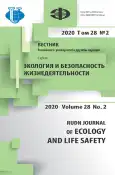Anthropogenic impact on the Himalayan marmot population in Nepal
- 作者: Nikolskii A.A.1, Vanisova E.A.1
-
隶属关系:
- Peoples’ Friendship University of Russia (RUDN University)
- 期: 卷 28, 编号 2 (2020)
- 页面: 153-159
- 栏目: Ecology
- URL: https://journal-vniispk.ru/2313-2310/article/view/323885
- DOI: https://doi.org/10.22363/2313-2310-2020-28-2-153-159
- ID: 323885
如何引用文章
全文:
详细
Anthropogenic impact on the Himalayan marmot population in Nepal is discussed. Above the upper border of the forest, human shares the same habitats with marmots on the alluvial terraces of river valleys. Human buildings and farmland lead to fragmentation of the marmot population, and overgrazing leads to pasture digression, worsening the food supply of these rodents. At the same time, people regularly catch marmots with loops, while, in accordance with the criteria of the IUCN Red List, the population of the Himalayan marmot in Nepal should be classified as Endangered (EN) - a very high risk of extinction in the wild.
作者简介
Alexander Nikolskii
Peoples’ Friendship University of Russia (RUDN University)
编辑信件的主要联系方式.
Email: bobak@list.ru
Doctor of Biological Sciences, Professor, Professor of the Department of System Ecology of the Faculty of Ecology
8 Podolskoye Hwy, bldg 5, Moscow, 115093, Russian FederationElena Vanisova
Peoples’ Friendship University of Russia (RUDN University)
Email: vanhelen@mail.ru
PhD in Biological Sciences, Associate Professor of the Department of System Ecology of the Faculty of Ecology
8 Podolskoye Hwy, bldg 5, Moscow, 115093, Russian Federation参考
- Rumiantsev VYu. Vertteilung der Murmeltiere in Eurasien (Die Karte). In: Bibikov DI. Die Murmeltiere der Welt. Magdeburg: Westarp Wiss.; 1996. p. 25.
- Hoffmann RS, Lunde D, MacKinnon J, Wilson DE, Wozencraft WC. Guide to the Mammals of China. Princeton: Princeton University Press; 2010.
- Nikolskii AA, Ulak A. On a range of Marmota himalayana (Rodentia, Sciuridae) in Nepal as the southernmost border of its distribution. Russian Journal of Zoology. 2005; 84(2):282-284. (In Russ.)
- Nikolskii AA, Ulak A. Key factors determining the ecological niche of the Himalayan marmot Marmota himalayana (Hodgson, 1841). Russian Journal of Ecology. 2006;37(1):46-52.
- Poudel BS, Spooner PG, Matthews A. Pastoralist disturbance effects of Himalayan marmot foraging and vigilance activity. Ecological Research. 2016;31(1):93-104.
- The IUCN Red List of Threatened Species. Available from: https://www.iucnredlist.org/ (accessed: 12.01.2020).
补充文件









